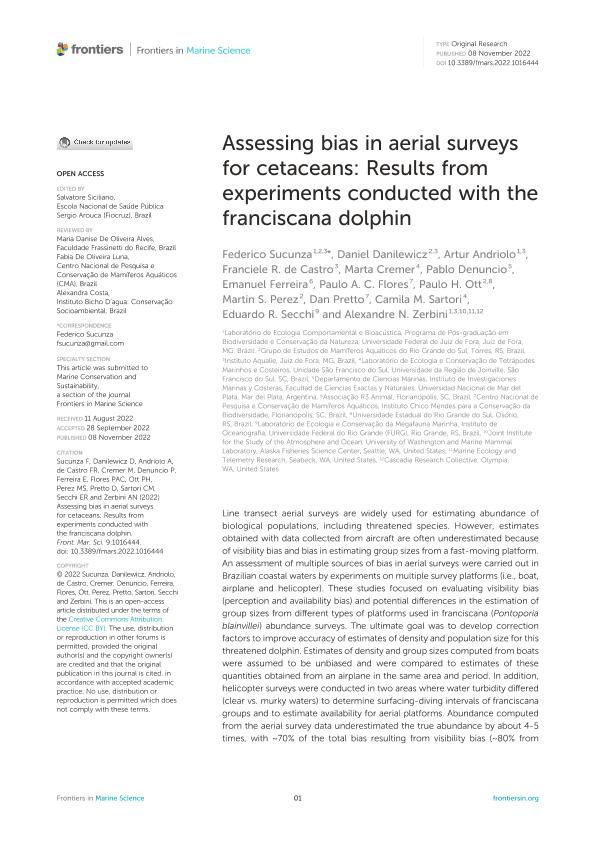Mostrar el registro sencillo del ítem
dc.contributor.author
Sucunza, Federico
dc.contributor.author
Danilewicz, Daniel
dc.contributor.author
Andriolo, Artur
dc.contributor.author
de Castro, Franciele R.
dc.contributor.author
Cremer, Marta
dc.contributor.author
Denuncio, Pablo Ezequiel

dc.contributor.author
Ferreira, Emanuel
dc.contributor.author
Flores, Paulo A. C.

dc.contributor.author
Ott, Paulo H.
dc.contributor.author
Perez, Martin S.
dc.contributor.author
Pretto, Dan
dc.contributor.author
Sartori, Camila M.
dc.contributor.author
Secchi, Eduardo Resende

dc.contributor.author
Zerbini, Alexandre

dc.date.available
2023-07-25T13:32:36Z
dc.date.issued
2022-11-08
dc.identifier.citation
Sucunza, Federico; Danilewicz, Daniel; Andriolo, Artur; de Castro, Franciele R.; Cremer, Marta; et al.; Assessing bias in aerial surveys for cetaceans: Results from experiments conducted with the franciscana dolphin; Frontiers Media; Frontiers In Marine Science; 9; 8-11-2022; 1-14
dc.identifier.issn
2296-7745
dc.identifier.uri
http://hdl.handle.net/11336/205274
dc.description.abstract
Line transect aerial surveys are widely used for estimating abundance of biological populations, including threatened species. However, estimates obtained with data collected from aircraft are often underestimated because of visibility bias and bias in estimating group sizes from a fast-moving platform. An assessment of multiple sources of bias in aerial surveys were carried out in Brazilian coastal waters by experiments on multiple survey platforms (i.e., boat, airplane and helicopter). These studies focused on evaluating visibility bias (perception and availability bias) and potential differences in the estimation of group sizes from different types of platforms used in franciscana (Pontoporia blainvillei) abundance surveys. The ultimate goal was to develop correction factors to improve accuracy of estimates of density and population size for this threatened dolphin. Estimates of density and group sizes computed from boats were assumed to be unbiased and were compared to estimates of these quantities obtained from an airplane in the same area and period. In addition, helicopter surveys were conducted in two areas where water turbidity differed (clear vs. murky waters) to determine surfacing-diving intervals of franciscana groups and to estimate availability for aerial platforms. Abundance computed from the aerial survey data underestimated the true abundance by about 4-5 times, with ~70% of the total bias resulting from visibility bias (~80% from availability bias and ~20% from perception bias) and ~30% from bias in estimates of group size. The use of multiple survey platforms in contrasting habitats provided the opportunity to compute correction factors that can be used to refine range wide abundance estimates of the threatened franciscana given certain assumptions are met. Visibility bias and group size bias were substantial and clearly indicate the importance for accounting for such correction factors to produce unequivocal population assessment based on aerial survey data.
dc.format
application/pdf
dc.language.iso
eng
dc.publisher
Frontiers Media

dc.rights
info:eu-repo/semantics/openAccess
dc.rights.uri
https://creativecommons.org/licenses/by/2.5/ar/
dc.subject
ABUNDANCE ESTIMATION
dc.subject
AERIAL SURVEY
dc.subject
AVAILABILITY BIAS
dc.subject
CETACEANS
dc.subject
FRANCISCANA DOLPHIN
dc.subject
GROUP SIZE BIAS
dc.subject
PERCEPTION BIAS
dc.subject
THREATENED SPECIES
dc.subject.classification
Biología Marina, Limnología

dc.subject.classification
Ciencias Biológicas

dc.subject.classification
CIENCIAS NATURALES Y EXACTAS

dc.title
Assessing bias in aerial surveys for cetaceans: Results from experiments conducted with the franciscana dolphin
dc.type
info:eu-repo/semantics/article
dc.type
info:ar-repo/semantics/artículo
dc.type
info:eu-repo/semantics/publishedVersion
dc.date.updated
2023-07-06T22:16:29Z
dc.journal.volume
9
dc.journal.pagination
1-14
dc.journal.pais
Suiza

dc.journal.ciudad
Lausana
dc.description.fil
Fil: Sucunza, Federico. Grupo de Estudio de Mamiferos Aquaticos de Rio Grande Do Sul.; Brasil. Universidade Federal de Juiz de Fora; Brasil. Instituto Aqualie; Brasil
dc.description.fil
Fil: Danilewicz, Daniel. Instituto Aqualie; Brasil. Grupo de Estudio de Mamiferos Aquaticos de Rio Grande Do Sul.; Brasil. Universidade Federal de Juiz de Fora; Brasil
dc.description.fil
Fil: Andriolo, Artur. Instituto Aqualie; Brasil. Universidade Federal de Juiz de Fora; Brasil
dc.description.fil
Fil: de Castro, Franciele R.. Instituto Aqualie; Brasil
dc.description.fil
Fil: Cremer, Marta. Universidade da Região de Joinville; Brasil
dc.description.fil
Fil: Denuncio, Pablo Ezequiel. Consejo Nacional de Investigaciones Científicas y Técnicas. Centro Científico Tecnológico Conicet - Mar del Plata. Instituto de Investigaciones Marinas y Costeras. Universidad Nacional de Mar del Plata. Facultad de Ciencias Exactas y Naturales. Instituto de Investigaciones Marinas y Costeras; Argentina
dc.description.fil
Fil: Ferreira, Emanuel. Associação R3 Animal; Brasil
dc.description.fil
Fil: Flores, Paulo A. C.. Instituto Chico Mendes para a Conservação da Biodiversidade; Brasil
dc.description.fil
Fil: Ott, Paulo H.. Universidade Estadual do Rio Grande do Sul; Brasil. Grupo de Estudio de Mamiferos Aquaticos de Rio Grande Do Sul.; Brasil
dc.description.fil
Fil: Perez, Martin S.. Grupo de Estudio de Mamiferos Aquaticos de Rio Grande Do Sul.; Brasil
dc.description.fil
Fil: Pretto, Dan. Instituto Chico Mendes Para A Conservação Da Biodiversidade; Brasil
dc.description.fil
Fil: Sartori, Camila M.. Universidade da Região de Joinville; Brasil
dc.description.fil
Fil: Secchi, Eduardo Resende. Universidade Federal do Rio Grande; Brasil
dc.description.fil
Fil: Zerbini, Alexandre. Marine Ecology And Telemetry Research; Estados Unidos. Cascadia Research Collective; Estados Unidos. Instituto Aqualie; Brasil. Universidade Federal de Juiz de Fora; Brasil. The George Washington University; Estados Unidos
dc.journal.title
Frontiers In Marine Science

dc.relation.alternativeid
info:eu-repo/semantics/altIdentifier/doi/http://dx.doi.org/10.3389/fmars.2022.1016444
dc.relation.alternativeid
info:eu-repo/semantics/altIdentifier/url/https://www.frontiersin.org/articles/10.3389/fmars.2022.1016444/full
Archivos asociados
